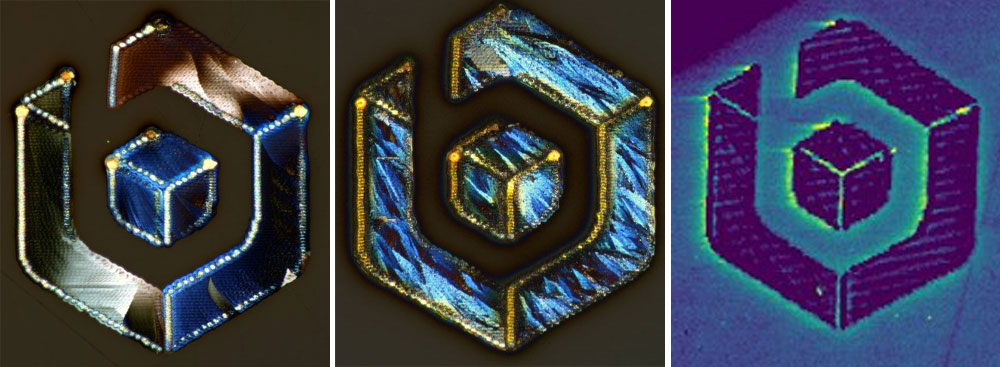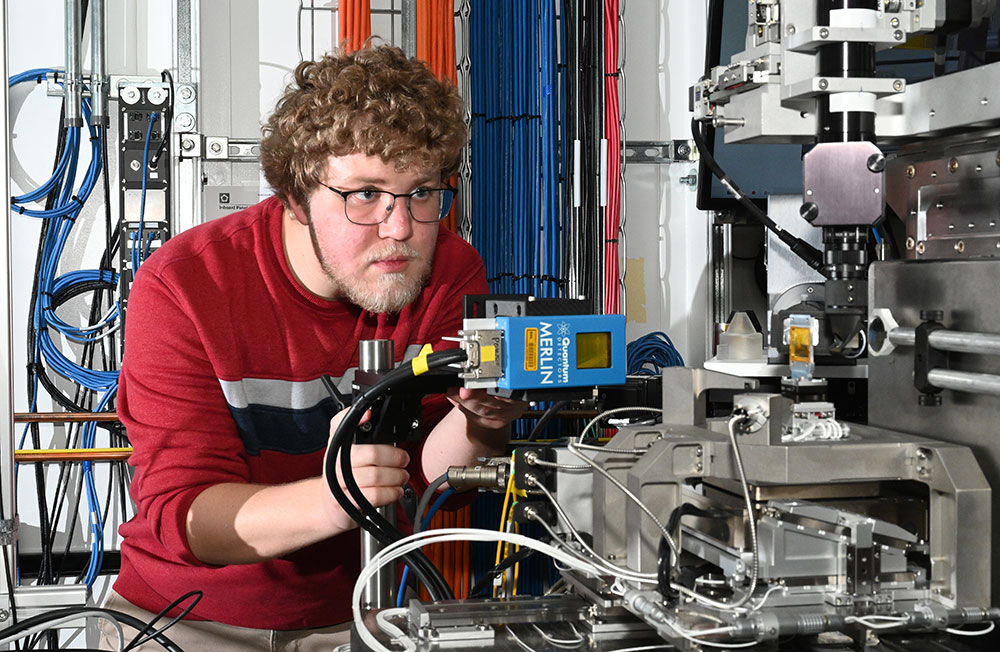Imparting Glass with New Properties
DOE research award winner and new NSLS-II postdoc Evan Musterman aims to enhance capabilities at the SRX beamline via his research into glass crystallization
January 5, 2024
In the summer of 2022, Lehigh University graduate student Evan Musterman arrived at the U.S. Department of Energy’s (DOE) Brookhaven National Laboratory to begin a research project at National Synchrotron Light Source II (NSLS-II), a DOE Office of Science user facility. As one of the 2022 funding recipients of DOE’s Office of Science Graduate Student Research (SCGSR) program, he was beginning a nine-month-long project as part of his PhD work. But what started with a temporary stint has turned into a full-time position as a NSLS-II postdoctoral researcher at the Submicron Resolution X-ray Spectroscopy (SRX) beamline.
Musterman joined the NSLS-II team in September of 2023. He is continuing his research into how lasers interact with glass, the focus of his project for SCGSR. This program funds several months of research for Ph.D. candidates in science, technology, engineering, and mathematics (STEM) fields at DOE facilities. Ultimately, he aims to use his research to impart glass with specific optical or electronic properties, which could help lead to brand-new uses for glass in emerging technologies.
“The way that SCGSR operates is beneficial for individual research,” said Andrew Kiss, lead beamline scientist at SRX and Musterman’s NSLS-II mentor. “It also provides students the opportunity to experience life at the Lab—having access to world-leading equipment, meeting with experienced researchers, and discussing science with them."
Musterman is especially interested in what happens to glass as it crystallizes under the intensity of a laser: How does it “know” when to crystallize? What is happening to the glass just before crystallization occurs? These were the questions he proposed in his SCGSR application and would try to answer at NSLS-II, building upon the work he had been doing at Lehigh with his advisor, Himanshu Jain. Jain is Lehigh’s T.L. diamond distinguished chair in engineering and a applied science and professor of materials science and engineering. He is also an NSLS-II user, taking advantage of the official partnership between Lehigh and NSLS-II that was forged in 2018 to advance materials science research.
Musterman is also continuing a project that developed—and was critical to—his glass research: developing a time-resolved x-ray absorption spectroscopy technique for SRX that will add to the beamline’s capabilities.
The Element of Time
The advantage of SRX for this type of study is, as its name suggests, its ability to resolve the details of materials at the submicron scale, which is below a millionth of meter. In this case, Musterman is probing the area of the glass that is being heated within the laser focus.
One technique used at SRX is extended x-ray absorption fine structure (EXAFS), which is a type of x-ray absorption spectroscopy (XAS). XAS techniques glean information about a sample based on how it absorbs x-rays and can tell scientists about the sample’s local atomic geometry—what elements are bonded to each other—and electronic structure—the energy levels surrounding each atom. EXAFS is particularly useful for measuring inter-atomic distances and the dynamics of the atomic lattice in a crystal. It can even yield some of this information for amorphous, non-crystalline materials, such as glass.
But EXAFS is not a technique that can be easily set up to follow a sample’s evolution over time. While there are several time-resolved EXAFS-capable beamlines in the U.S., none offer the spatial and temporal resolution that Musterman would need. Since he didn’t know when the glass would crystallize once hit with the laser—it is generally under a minute, but that is a big range in experimental terms—using a conventional time-resolved technique wasn’t a viable option.
“The idea for my project was to create a new method of time-resolved EXAFS,” said Musterman. “Instead of scanning the glass sample over a range of energies, we pick one energy and crystallize the glass there, then move to the next energy and do it again. In the end, we hope to be able to ‘stitch’ these pieces together for a full picture of laser-induced glass crystallization.”
The main goal is to be able to “see” and understand what happens to the glass right before it crystallizes, such as discovering any unanticipated structural states. With this information, it could be possible to control the crystallization and thus tailor the material with optical-electronic properties that are not normally possible in glass alone. One example is piezoelectricity, the ability to generate electric charge in response to a physical stress.
Setting Up at the Beamline
Musterman’s first access to SRX was in August of 2022, which was possible by taking advantage of some of Kiss’ discretionary beam time. This session, and the time leading up to his first “official” experiment in November as a general user, was meant to be exploratory. He and Kiss wanted to find out how viable their proposed approach could be and try out some different options, such as what x-ray detector they would use, where it would be placed, what types of glass would yield the best results.
Day one at the beamline was a testament to the trial-and-error that so often defines the initial stages of a study. After setting up the optical microscope, they realized that the laser and the x-ray beams were out of alignment, meaning the microscope had to be taken apart. This was the first issue that would need resolving, beginning several weeks of experimenting with the beamline setup and different glass types. Because he had begun working right before a planned NSLS-II shutdown, however, his beamline setup didn’t have to be dismantled entirely. This turned out to be beneficial.
“Andy planned that well,” said Musterman. “I came to him with a lot of ideas for experiments and things we should try, and he made them happen. There were three months until the next block of beam time; I wanted to make that time count.”
One product of this experimental period was a series of images of crystal samples created in the shape of the Brookhaven Lab logo. Musterman wrote code to process the images such that the individual crystals were visible—and the results are beautiful.
 enlarge
enlarge
Three Brookhaven Lab logos fabricated from crystal samples. The first two are made with different laser parameters and the third is the result of chemical mapping with the x-ray beam. (Evan Musterman/Brookhaven National Laboratory)
Just prior to his first official block of beamtime as a general user, Musterman was able to set up the laser early. This time, the experimental setup worked immediately—so well, in fact, that during his scheduled beam time, he and Kiss had little to do at the beamline besides watch the data stream in.
“We had accomplished our one full data set,” he said. “We didn’t know yet if it meant anything, but the experiments were working.”
Learning from the Data
Musterman’s next block of beam time took place in February of 2023. The goal for that study was to extract meaningful, interpretable data from what they would collect, ideally while it was being collected. However, a component at the beamline malfunctioned and it would be several weeks before the beamline was running again and some beam time was available.
“But once there was an opportunity to access the beamline again, I was immediately able to perform another round of experiments,” said Musterman. “This is a benefit of working on-site at the Lab.”
By that point, Musterman and Kiss had been able to gather better data, but they still weren’t sure what that data would reveal. There was some evidence that the laser did, indeed, influence the structure of the glass right before crystallization occurred. They also saw spectroscopic signatures that the glass had crystallized.
“At that point, how successful we were was still a bit of a mystery,” said Musterman. “Analyzing the data from the new method would take some time.”
He continued, “If the data showed a changing structure, that would be something we’d want to publish. And if not, we still had a new technique that worked, but perhaps one that needed some more fine-tuning.”
Next Steps
By the end of his SCGSR award period, Musterman had a technique that was developing nicely and a large set of data to analyze. He began processing the data into a more useable form, an effort that would become part of the last chapter of his dissertation, which he completed and defended after returning to Lehigh.
Shortly after earning his Ph.D., he was hired as a postdoctoral researcher at NSLS-II, returning to SRX.
“This experience opened the door for Evan and was an opportunity to meet many scientists and make connections,” said Kiss. “When a postdoc opportunity opened up at SRX, he was already familiar with the national lab environment and we had first-hand experience with his work ethic and skillset. While the hiring process is highly competitive, ultimately Evan demonstrated himself as the top candidate and we are extremely happy to have him at the beamline developing new techniques.”
Musterman is continuing some of his SCGSR work as well as starting a new project: making x-ray diffraction (XRD) mapping a new capability at SRX. XRD mapping is a way of obtaining enhanced structural information from a sample via a pixel-by-pixel scan.
“As a postdoc, I am building upon the skills and experience I gained during my SCGSR award period, both by working with and learning from the glass crystallization data I obtained and, hopefully, bringing XRD mapping to the SRX users,” he said.
Brookhaven National Laboratory is supported by the Office of Science of the U.S. Department of Energy. The Office of Science is the single largest supporter of basic research in the physical sciences in the United States and is working to address some of the most pressing challenges of our time. For more information, visit science.energy.gov.
Follow @BrookhavenLab on social media. Find us on Instagram, LinkedIn, X, and Facebook.
2024-21618 | INT/EXT | Newsroom










